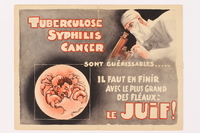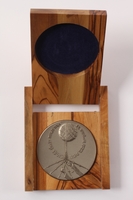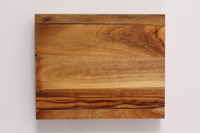Overview
- Description
- The Rudy Appel papers include Red Cross form correspondence among Rudy Appel, his mother in Gurs, and his father in Philadelphia as well as photographs of the La Guespy children's home run by Secours Suisse aux enfants where Appel was sheltered during the war, the home's director Juliette Usach, and other children who stayed at the home.
- Date
-
inclusive:
1939-1944
- Credit Line
- United States Holocaust Memorial Museum Collection, Gift of Rudy Appel
- Collection Creator
- Rudy Appel
- Biography
-
Rudolf (Rudi) Appel (later Rudy, 1925-2016) was born in Mannheim, Germany, to Julius (1881-1952) and Rose (or Rosa, nee Hofmann, later Strauss,1895-1974) Appel. He had one older brother, Martin (1922-2005). The family lived in Mannheim, Julius worked as a legal professional, and Rudi attended gymnasium. On November 9 and 10, 1938, German officials instigated pogroms of violence and destruction against Jews and their property, known as Kristallnacht. During the pogroms, 30,000 Jewish men were also incarcerated in German concentration camps and held unless they promised to leave Germany. Julius was among the men imprisoned and arrived in Dachau concentration camp on November 11. On November 15, the Nazis banned Jewish students from public schools, so Rudi began attending a Jewish school in Mannheim. At the end of November, Martin left Europe and immigrated to the United States, joining Julius’ brother, Ernst, who lived in New York City. Upon Julius’ release from Dachau, he also left Germany and arrived in New York City on January 18, 1939. Julius joined Martin, who had moved to Philadelphia. That same year, Rose fled to Belgium. Rudi was sent to Rotterdam, Netherlands, for safety and where he could attend gymnasium.
In May and June of 1940, Germany invaded and occupied the Low Countries of Netherlands, Belgium, and Luxembourg, as well as France. Rudi was smuggled over the border and joined his mother in Belgium. Rudi and Rose then crossed into Nazi-occupied France, heading towards Marseille on the southern coast. While attempting to cross into un-occupied territory, they were arrested near Angouleme and sent to Rivesaltes internment camp. On August 26, 1942, Rudi was transferred to Camp Les Milles near Marseille. That summer, the French, collaborationist Vichy government began handing over Jews in the camps to the Nazis. During the daily selection on September 1, Rudi decided to join the selected group, even though his name was not called. The group Rudi was supposed to have been in was sent to Drancy transit camp, and eventually went to Auschwitz killing center in German-occupied Poland. Instead, Rudi ended up back in Rivesaltes.
In September 1942, Rudi was among a group of children escorted by Friedel Reiter (later Bohny-Reiter) to Le Chambon sur Lignon, a Protestant village in unoccupied France. In Chambon, Rudi was placed in La Guespy, one of several children’s homes in the town operated by Secours Suisse aux Enfants (Swiss Society for Children’s Aid). La Guespy was directed by Juliette Usach, a doctor who fled to France during the Spanish Civil War. In November, Germany occupied the remainder of France, and Rose was sent to Gurs internment camp, where she worked in the Central Hospital. By the end of December, Rudi was among 23 children housed at Guespy. The children were able to resume schooling and lived in relative safety due to the entire town’s dedication to helping refugees. When roundups of Jews did occur, Rudi and the other children were hidden in the nearby woods. The children were encouraged to attend religious services, and Juliette consciously cultivated an atmosphere of religious tolerance and encouraged collective participation in both Jewish and non-Jewish holidays. While in Chambon and Gurs, Rudi and Rose were both able to exchange letters with Julius and Martin through the Red Cross.
On June 6, 1944, the Allies landed in Normandy, beginning the liberation of France. The region surrounding Chambon was liberated by the Free French First Armored Division on September 2-3. After the war, Rudi was reunited with his mother and in November1946 they immigrated to the United States, where Rudi Americanized his name to Rudy. Rose and Julius divorced in 1949, and that same year, Rose remarried to Dr. Alfred Strauss and moved to New York City. Rudy began an export business. In April 1962, Rudy married Susanne Ahr (b. 1928), a Berlin native who fled to Iraq in 1935, and then Uganda in 1941 where she was imprisoned as an enemy alien until 1945. Rudy became stepfather to her daughter. Rudy and Susanne had another daughter in 1964. After the end of the Soviet era, Rudy became dedicated to helping Jews get out of the USSR.
Physical Details
- Genre/Form
- Photographs.
- Extent
-
2 folders
- System of Arrangement
- The Rudy Appel papers are arranged as a single series: I. Rudy Appel papers, 1939-1944
Rights & Restrictions
- Conditions on Access
- There are no known restrictions on access to this material.
- Conditions on Use
- Material(s) in this collection may be protected by copyright and/or related rights. You do not require further permission from the Museum to use this material. The user is solely responsible for making a determination as to if and how the material may be used.
Keywords & Subjects
- Topical Term
- Jews--Germany--Mannheim. Jews, German--France. Jewish refugees--France. Jewish children in the Holocaust--France--Le Chambon-sur-Lignon. Hidden children (Holocaust)--France--Le Chambon-sur-Lignon. World War, 1939-1945--Jews--Rescue--France. Concentration camp inmates--France--Gurs--Correspondence.
Administrative Notes
- Holder of Originals
-
United States Holocaust Memorial Museum
- Legal Status
- Permanent Collection
- Provenance
- Rudy Appel donated the Rudy Appel papers to the United States Holocaust Memorial Museum in 1991and 1992. The accessions formerly cataloged as 1992.70 and 1992.72 have been incorporated into this collection.
- Funding Note
- The cataloging of this collection has been supported by a grant from the Conference on Jewish Material Claims Against Germany.
- Primary Number
- 1991.209.7
- Record last modified:
- 2024-03-20 07:23:59
- This page:
- https://collections.ushmm.org/search/catalog/irn608011
Additional Resources
Download & Licensing
In-Person Research
- Available for Research
- Plan a Research Visit
-
Request in Shapell Center Reading Room
Bowie, MD
Contact Us
Also in Rudy Appel collection
The collection consists of a medal, certificate, poster, photographs, and correspondence relating to the experiences of Rudy Appel, his parents, Julius and Rose Appel, and caretaker, Juliette Usach, in Germany, the Netherlands, Belgium, and France before, during, and after the Holocaust.
Date: 1939-1990

Antisemitic flyer acquired by a French Jewish child in hiding
Object
Antisemitic propaganda flyer found pinned to a wall and acquired by Rudy Appel in wartime France. The image depicts a louse-like caricature of a Jew and compares Jews to well-known diseases. This message draws upon centuries-old antisemitic stereotypes of Jews as dirty and vectors of disease. Pejoratives such as “dirty Jew” and antisemitic myths such as a Jewish odor caused by bad hygiene or a poor diet were common during the 19th century. Rudy was living with his parents and brother in Mannheim, Germany, when Adolf Hitler and the Nazis came to power in January 1933. Following the Kristallnacht pogroms in November 1938, Rudy’s father Julius was imprisoned in Dachau concentration camp, and his brother, Martin, immigrated to the United States. Julius followed when he was released from Dachau in January 1939. Rudy was sent to a school in Rotterdam, Netherlands, while his mother, Rose, fled to Belgium. When Germany invaded western Europe in May 1940, Rudy joined his mother in Belgium. The pair attempted to escape to unoccupied southern France, but were arrested near Angouleme and sent to Rivesaltes internment camp. In September 1942, Rudi was among a group of children escorted by Friedel Reiter (later Bohny-Reiter) to Le Chambon sur Lignon, a Protestant village in southern France. He was placed in La Guespy, a children’s home in the town operated by Secours Suisse aux Enfants (Swiss Society for Children’s Aid). Rudy was able to resume schooling and lived in relative safety due to the entire town’s dedication to helping refugees. The region surrounding Chambon was liberated by the Free French First Armored Division on September 2-3. After the war, Rudy reunited with his mother and in November 1946, they immigrated to the United States.

Righteous Among the Nations medal awarded to a French children’s home director
Object
Medal awarded posthumously to Juliette Usach in recognition as a “Righteous Among the Nations,” by Yad Vashem in Jerusalem, Israel. Yad Vashem confers the honor on those who risked their lives to save Jews during the Holocaust. Juliette Usach was a Protestant, Spanish doctor who fled to France in 1938 as a refugee of the Spanish Civil War. In 1939, she moved to the village of Chambon-sur-Lignon to become the director of a boarding house for Spanish mothers and children. After Germany’s invasion of France in May 1940, antisemitic legislation led to Jews being imprisoned in internment camps. Chambon became a haven for refugees, and the entire town worked together to create a welcoming and safe environment. With assistance from numerous organizations, Chambon’s pastor, André Trocmé, arranged the release of many Jewish children from the camps. Juliette’s house was refurbished, and on May 14, 1941, reopened as “La Guespy,” the first of what would become several children’s homes in Chambon. While at La Guespy, children resumed schooling and were encouraged to attend religious services. Juliette consciously cultivated an atmosphere of religious tolerance and encouraged collective participation in both Jewish and non-Jewish holidays. Following the liberation of France in September 1944, Juliette remained in Chambon until 1964, when she moved to Lyon to join the Salvation Army.

Presentation box for medal awarded to a French children’s home director
Object
Presentation box for medal awarded posthumously to Juliette Usach in recognition as a “Righteous Among the Nations,” by Yad Vashem in Jerusalem, Israel. Yad Vashem confers the honor on those who risked their lives to save Jews during the Holocaust. Juliette Usach was a Protestant, Spanish doctor who fled to France in 1938 as a refugee of the Spanish Civil War. In 1939, she moved to the village of Chambon-sur-Lignon to become the director of a boarding house for Spanish mothers and children. After Germany’s invasion of France in May 1940, antisemitic legislation led to Jews being imprisoned in internment camps. Chambon became a haven for refugees, and the entire town worked together to create a welcoming and safe environment. With assistance from numerous organizations, Chambon’s pastor, André Trocmé, arranged the release of many Jewish children from the camps. Juliette’s house was refurbished, and on May 14, 1941, reopened as “La Guespy,” the first of what would become several children’s homes in Chambon. While at La Guespy, children resumed schooling and were encouraged to attend religious services. Juliette consciously cultivated an atmosphere of religious tolerance and encouraged collective participation in both Jewish and non-Jewish holidays. Following the liberation of France in September 1944, Juliette remained in Chambon until 1964, when she moved to Lyon to join the Salvation Army.
Honorary certificate issued to Juliette Usach by Yad Vashem
Object
Certificate awarded posthumously to Juliette Usach in recognition as a “Righteous Among the Nations,” by Yad Vashem in Jerusalem, Israel. Yad Vashem confers the honor on those who risked their lives to save Jews during the Holocaust. Juliette Usach was a Protestant, Spanish doctor who fled to France in 1938 as a refugee of the Spanish Civil War. In 1939, she moved to the village of Chambon-sur-Lignon to become the director of a boarding house for Spanish mothers and children. After Germany’s invasion of France in May 1940, antisemitic legislation led to Jews being imprisoned in internment camps. Chambon became a haven for refugees, and the entire town worked together to create a welcoming and safe environment. With assistance from numerous organizations, Chambon’s pastor, André Trocmé, arranged the release of many Jewish children from the camps. Juliette’s house was refurbished, and on May 14, 1941, reopened as “La Guespy,” the first of what would become several children’s homes in Chambon. While at La Guespy, children resumed schooling and were encouraged to attend religious services. Juliette consciously cultivated an atmosphere of religious tolerance and encouraged collective participation in both Jewish and non-Jewish holidays. Following the liberation of France in September 1944, Juliette remained in Chambon until 1964, when she moved to Lyon to join the Salvation Army.
Bifold document case for a certificate issued to Juliette Usach by Yad Vashem
Object
Document case for a certificate (.2a) awarded posthumously to Juliette Usach in recognition as a “Righteous Among the Nations,” by Yad Vashem in Jerusalem, Israel. Yad Vashem confers the honor on those who risked their lives to save Jews during the Holocaust. Juliette Usach was a Protestant, Spanish doctor who fled to France in 1938 as a refugee of the Spanish Civil War. In 1939, she moved to the village of Chambon-sur-Lignon to become the director of a boarding house for Spanish mothers and children. After Germany’s invasion of France in May 1940, antisemitic legislation led to Jews being imprisoned in internment camps. Chambon became a haven for refugees, and the entire town worked together to create a welcoming and safe environment. With assistance from numerous organizations, Chambon’s pastor, André Trocmé, arranged the release of many Jewish children from the camps. Juliette’s house was refurbished, and on May 14, 1941, reopened as “La Guespy,” the first of what would become several children’s homes in Chambon. While at La Guespy, children resumed schooling and were encouraged to attend religious services. Juliette consciously cultivated an atmosphere of religious tolerance and encouraged collective participation in both Jewish and non-Jewish holidays. Following the liberation of France in September 1944, Juliette remained in Chambon until 1964, when she moved to Lyon to join the Salvation Army.



